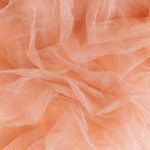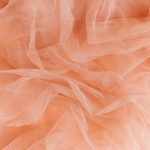Gauze fabric is a lightweight, breathable material usually made from cotton, silk, polyester, or blends. You’ll find it soft, airy, and perfect for everything from summer clothes to medical bandages. Its open weave allows air to flow easily, keeping you cool and comfortable. Gauze is great for delicate uses but can require special sewing and care. If you want to know how to pick the best type and care for it properly, there’s much more to explore ahead.
Table of Contents
Key Takeaways
- Gauze fabric is a lightweight, breathable material with an open weave, commonly made from cotton, silk, polyester, or fiber blends.
- It originated in ancient Egypt and Mesopotamia, historically used for medical bandages and delicate clothing.
- Key characteristics include softness, air circulation, quick drying, and flexibility, making it ideal for warm weather and sensitive skin.
- Common uses range from summer clothing and baby items to medical dressings and lightweight home decor like curtains.
- Sewing gauze requires sharp needles, long stitches, pre-washing, and gentle care to maintain its delicate texture and durability.
What Is Gauze Fabric Made Of?
Gauze fabric is typically made from cotton, but you might also find versions crafted from silk, polyester, or a blend of fibers.
When you choose gauze, cotton offers breathability and softness, making it perfect for clothing or medical use. Silk gauze, on the other hand, provides a delicate, luxurious feel, often used in high-end fashion or lightweight scarves.
Polyester gauze is durable and resistant to wrinkles, ideal if you want easy care and longevity. Blended fibers combine the best traits—like softness with durability.
Polyester gauze offers durability and wrinkle resistance, while blends provide softness paired with lasting strength.
The loosely woven structure of gauze fabric gives it a unique texture and allows air to circulate, which you’ll notice immediately. Depending on the fiber content, gauze can be sheer or slightly opaque, so you can pick the one that suits your project best.
The History and Origins of Gauze Fabric
Although its exact beginnings are hard to pinpoint, gauze fabric has a rich history that dates back centuries. You’ll find that gauze was initially used in ancient Egypt and Mesopotamia for medical and practical purposes.
Over time, it gained popularity in textile and fashion industries due to its lightweight and breathable qualities. As you explore its origins, keep these key points in mind:
- Gauze’s name likely comes from Gaza, a city known for producing fine woven textiles.
- Medieval Europe used gauze primarily for bandages and delicate clothing.
- The fabric evolved with weaving techniques, becoming a staple in both healthcare and apparel.
Understanding this background helps you appreciate gauze’s versatility and enduring significance.
Different Types of Gauze Fabric
You’ll find several common types of gauze fabric, each suited for different purposes.
Understanding the unique qualities of each variety helps you pick the right one for your needs.
Let’s explore how these types vary and where you can best use them.
Common Gauze Varieties
Several popular varieties of gauze fabric offer different textures, weights, and uses to suit your needs. Understanding these common types helps you pick the right fabric for your project.
Here are three main varieties you’ll often encounter:
- Cotton Gauze: Lightweight and breathable, perfect for clothing and baby products. It’s soft, absorbent, and easy to care for.
- Silk Gauze: Delicate and luxurious, with a smooth texture that adds elegance to scarves or overlays. It’s less durable but visually stunning.
- Polyester Gauze: More durable and resistant to wrinkles and shrinking. It’s ideal when you want a longer-lasting fabric that still feels light.
Each type gives you a unique feel and appearance, so choose according to your project’s needs and desired look.
Uses by Fabric Type
Three main types of gauze fabric serve distinct purposes, making it easy for you to select the best fit for your project.
Cotton gauze is soft and breathable, perfect for baby clothes, lightweight scarves, and summer dresses. It’s also great if you want something gentle against the skin.
Polyester gauze offers durability and wrinkle resistance, ideal for costumes, decorations, or crafts that need a bit more structure.
For medical uses, sterile gauze is your go-to; it’s designed to absorb fluids and protect wounds.
Knowing these differences helps you pick gauze that matches your needs, whether you’re sewing, crafting, or handling first aid. Each type’s unique qualities guarantee your project turns out just right.
Key Characteristics of Gauze Fabric
You’ll notice gauze fabric is incredibly lightweight and breathable, making it perfect for warm weather or sensitive skin.
Its open weave structure allows air to flow freely, keeping you cool and comfortable.
Let’s explore how these key features impact its uses and care.
Lightweight and Breathable
Lightness defines gauze fabric, making it an ideal choice when comfort and airflow matter most. You’ll appreciate how easily gauze feels against your skin, especially during warm weather or after a workout.
Its breathable nature helps keep you cool and prevents overheating, making it perfect for clothing, baby wraps, and even bedding.
When you choose gauze fabric, you benefit from:
- Minimal weight that won’t weigh you down or feel bulky
- Exceptional air circulation that promotes ventilation and reduces sweat
- A soft texture that gently caresses your skin without irritation
This combination guarantees you stay comfortable all day without sacrificing style or practicality.
With gauze, you get lightweight fabric that breathes as hard as you do.
Open Weave Structure
Gauze fabric features a distinctive open weave structure that sets it apart from other textiles. When you look closely, you’ll notice the loosely woven threads create tiny gaps throughout the fabric.
This open weave allows air to flow freely, making the material incredibly breathable and comfortable to wear. You’ll find this structure gives gauze a lightweight feel and a delicate, slightly sheer appearance.
Because of these gaps, gauze dries quickly, which is why it’s popular for summer clothing, baby blankets, and even medical bandages. The open weave also makes the fabric flexible and soft, adapting easily to movement.
When you choose gauze, you’re getting a fabric that balances comfort, breathability, and versatility, all thanks to its unique open weave design.
Common Uses for Gauze Fabric
Although it may seem delicate, gauze fabric serves a variety of practical and creative purposes that you can easily explore. Its lightweight, breathable nature makes it ideal for projects where comfort and airflow matter.
You can use gauze fabric in a range of ways, from fashion to home essentials.
Here are some common uses you might find interesting:
- Clothing: Perfect for summer dresses, scarves, and baby clothes due to its softness and breathability.
- Medical Supplies: Often used for bandages and dressings because it’s gentle on skin and allows wounds to breathe.
- Home Decor: Great for curtains, tablecloths, and lightweight throws that add texture without heaviness.
Gauze fabric’s versatility means you can get creative while enjoying its functional benefits.
How to Choose the Right Gauze Fabric for Your Project
When selecting gauze fabric for your project, understanding its different types and qualities can make all the difference.
First, consider the weight and weave density—lighter gauze is airy and sheer, perfect for scarves or curtains, while denser gauze offers more opacity, suited for clothing or baby wraps.
Choose gauze weight wisely—light for sheer scarves, dense for opaque clothing and baby wraps.
Next, think about the fiber content; cotton gauze is breathable and soft, ideal for comfort, whereas synthetic blends may offer durability or stretch.
Also, pay attention to the texture—some gauze feels crisper, others softer.
Finally, match the fabric’s color and pattern to your design needs.
Tips for Sewing and Handling Gauze Fabric
Since gauze fabric is lightweight and loosely woven, you’ll need to handle it gently to prevent stretching or distortion.
When sewing, use sharp pins or clips to avoid snagging, and opt for a fine needle to prevent holes. Cut gauze on a flat surface to keep the fabric stable and consider using pattern weights instead of pins.
Keep these tips in mind:
- Use a walking foot or a straight stitch foot to feed the fabric evenly through your machine.
- Sew with a smaller stitch length to strengthen seams without puckering.
- Stabilize edges with lightweight interfacing or stay tape to reduce fraying and maintain shape.
Caring for and Washing Gauze Fabric
Because gauze fabric is delicate and loosely woven, you’ll want to handle washing and caring for it with extra attention to preserve its texture and shape. Always wash gauze fabric by hand or use a gentle cycle with cold water. Avoid wringing it out; instead, press the water out gently. Air drying flat is best to prevent stretching.
Here’s a quick care guide:
| Task | Recommendation |
|---|---|
| Washing | Hand wash or gentle cycle |
| Detergent | Use mild detergent |
| Drying | Lay flat to air dry |
Following these tips will keep your gauze fabric soft and intact for a long time. Avoid bleach and high heat to maintain its delicate fibers.
Where to Buy Quality Gauze Fabric
Although gauze fabric is widely available, finding high-quality options requires knowing where to look.
Finding quality gauze fabric takes a bit of know-how despite its wide availability.
You want fabric that feels soft, durable, and true to its lightweight nature. To get the best gauze fabric, consider these sources:
- Specialty Fabric Stores: These often carry premium gauze made from natural fibers, giving you quality and variety.
- Online Retailers: Websites like Etsy or fabric-specific shops offer a broad selection, with reviews to help you pick reliable sellers.
- Local Artisan Markets: Handmade gauze fabrics here can be unique and crafted with care, perfect if you want something special.
Frequently Asked Questions
Can Gauze Fabric Be Used for Medical Dressings at Home?
Yes, you can use gauze fabric for medical dressings at home. It’s breathable, absorbent, and helps protect wounds. Just make sure to keep it clean, change dressings regularly, and follow proper wound care steps.
Is Gauze Fabric Hypoallergenic for Sensitive Skin?
Did you know 70% of people with sensitive skin tolerate gauze well? You’ll find gauze fabric generally hypoallergenic, but always test a small patch first to avoid irritation, especially if your skin is super sensitive or allergy-prone.
How Breathable Is Gauze Fabric Compared to Cotton?
You’ll find gauze fabric more breathable than regular cotton because of its loose weave, which lets air flow freely. It’s perfect if you want lightweight, airy material that keeps you cool and comfortable.
Can Gauze Fabric Be Dyed Easily at Home?
Dyeing gauze fabric at home is like painting on a delicate cloud—you’ll find it soaks up color easily thanks to its open weave. Just use fabric dye, follow instructions, and enjoy your vibrant, airy masterpiece!
What Is the Environmental Impact of Producing Gauze Fabric?
You’ll find gauze fabric’s environmental impact depends on its material; natural fibers use water and chemicals, while synthetic ones rely on petroleum. Choosing organic or recycled gauze helps reduce harm and supports eco-friendly production practices.







